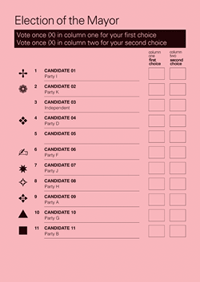Living in Northern Ireland, there’s part of me feels short changed that we’re not getting to vote today. After all, it is the land of vote early, vote often and tends towards there being some kind of election nearly every year.
(There’s an –ology for the stuffy of voting and elections, but I can’t figure out what it is!)
European elections under Proportional Representation (the Party List system).
Westminster elections under straight-forward First-past-the-post (known as Plurality in the trade).
Assembly elections to Stormont using Proportional Representation (Single Transferable Vote variant). Also used for local Council elections???
Ministerial positions on the Northern Ireland Executive are allocated using the D’Hondt method, and some MLA votes require cross-community support.
But no Mayoral elections. And certainly no Supplementary Vote method.

In today’s London elections, voters get to cast two votes for Mayor: their first and second preferences. Unless candidates are confident of an absolute win – ie, getting more than 50% of the first preference votes – the use of SV tends to encourage the candidates to reach out beyond their core supporters to secure the second preferences of rival groups. The editors of Wikipedia (people like you and me) suggest that the technique can
“create a more conciliatory campaigning style among candidates with similar policy platforms.”
Oh, and Londoners also have two other votes to cast for the London Assembly today. One for their local constituency representative (elected first past the post), and another for the top up list of parties and independents that make up the rest of the assembly (using a modified d'Hondt system). But that's just plain confusing.
London Elects, the organisation running the election, describe the counting procedure:
In this system, if a candidate receives more than half of the first choice votes he or she is elected.
If this does not happen, the two candidates with the most first choice votes go through to a second stage. All the other candidates are eliminated but the second choice votes on their ballot papers are reviewed. If they are for either of the top two candidates these votes are added to their totals.
The candidate with the most first and second choice votes wins. If there is a tie then the Greater London Returning Officer draws lots.
This voting system is used to ensure the candidate with the broadest amount of support from London is elected.
Since a picture is worth a thousand votes words, they’ve an animation to illustrate it.
So unless Ken or Boris rakes in half the first preference votes, they’ll be reliant on the second preference votes from the rest of the field to top them up. And unlike STV, there’s no fractions of a vote. Each second preference vote adds 1 to their tally.
So Ken could narrowly lose the first round to Boris, but come bouncing back with the second preferences. All to play for?
While the England and Wales local election results will dribble in throughout the night, counting for the London Mayoral contest doesn’t start until 9am tomorrow morning – split across three centres in Alexandra Palace, Excel and Olympia – where a fleet of paper scanners will swallow all the votes and spit out a definitive answer sometime in the evening.
As someone online suggested this week, Ken and Boris could be the UK's Obama and Hillary! (Slugger's Mick Fealty is twittering the election if you're keen.)
2 comments:
Yes, elections to the District Councils in Northern Ireland are also by STV-PR. And they have been since 1973.
You want to think yourself lucky you are NOT voting in these appalling elections for the Mayor of London and the London Assembly.
The big difference between STV to elect one winner (the Mayor) and the Supplementary Vote, is that all second choice votes that are not for one of the top-two in the run-off will be discarded and count for nothing. Had this been an STV election (UK = Alternative Vote, USA = IRV), ALL of those second choices could have counted through successive elimination. And of course, with STV (IRV) London voters would not have been restricted to making just two choices.
When it comes to the London Assembly election by AMS (Additional Member System = MMP), thousands and thousands of votes will be wasted - they will count for nothing. You should think yourself VERY fortunate that the Northern Ireland Assembly is elected by STV-PR.
Good God that's complicated! I suppose we're lucky having thoughtful local politicians who don't want to put us through all that bother.
Post a Comment